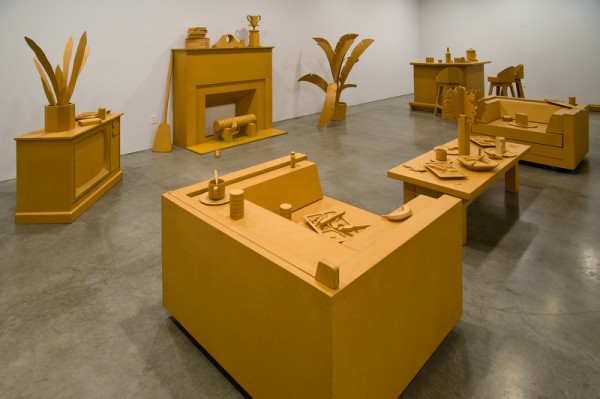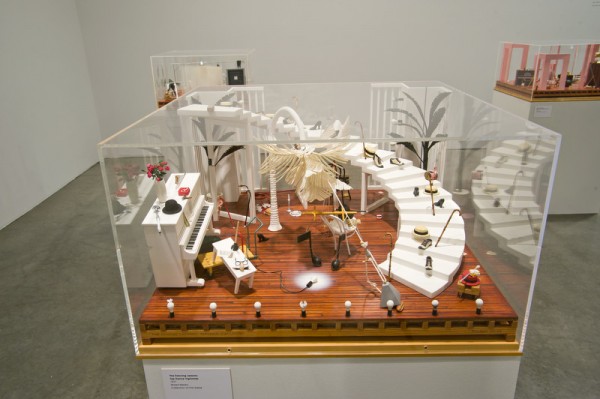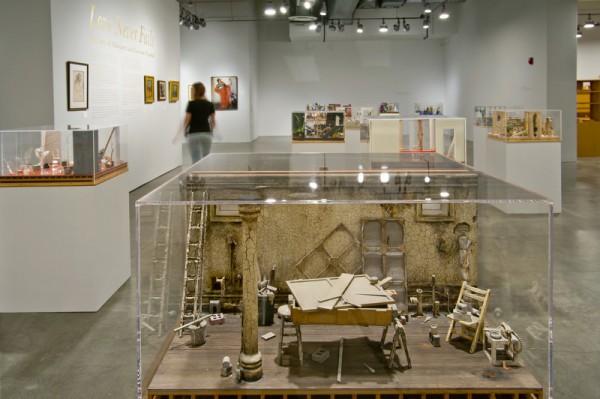“Roland Reiss, Personal Politics: Sculpture from the 1970s and 1980s” at the Pasadena Museum of California Art is not part of “Pacific Standard Time.” The Getty-funded project, advertised as a “region-wide initiative encompassing every major L.A. art movement from 1945 to 1980,” includes upwards of 150 exhibitions at upwards of 125 institutions, from Venice to Riverside and from Santa Barbara to San Diego, and runs for nearly an entire academic year, from October 2011 to April 2012. Much of it follows an educational model, or at least recalls a good slide lecture about ‘how it really was’ and ‘how the standard narratives have left out so much.’
It’s hard to image an exhibition like Reiss’s not fitting into the inclusive, spread-the-net-wide ambitions of the Getty’s mega-event, and that’s got conspiracy theorists mumbling. They’ve got a point: Reiss seems to be the type of artist whose kinky, out-of-step oeuvre is tailor-made for “Pacific Standard Time”: strange, idiosyncratic stuff that has flown beneath the radar yet never let up: from sturdy abstractions and spray-painted, 3-D shaped paintings in the 1950s and ’60s, to super-fantastic (as opposed to super-realistic) miniature sculptural tableaux (aka, homemade dioramas) in the ’70s and ’80s, to abstract paintings on canvas and Plexiglas in the ’90s and ’00s, to, finally, the playfully fatalistic flower paintings the 82-year-old artist has been making for the last four years or so.
The volume and quality of Reiss’s output so far outdistance the attention it has received that conspiracy-theorizing seems reasonable. But the fact of the matter is less nefariously glamorous and more mundanely depressing: Reiss’s work has been overlooked (and still is) because it is neither cool nor conceptual—in the narrowly defined ways coolness and conceptualness have become the sine qua non of art made in Los Angeles. His fabulously crafted dollhouse-size scenarios, even more than his super-synthetic paintings, are just too dorky, earnest, and intelligent, in the blue-collar, DIY way of a basement tinkerer, to be of much use to people who look to art in order to look cool to other lookers (aka, the powers that be). Such chic status-grubbing is as far away from the format of Reiss’s fearlessly corny works as it is from the absurd stories that stutter and sputter across their Lilliputian stages, the intrigue of their suspended narratives building both because of their inconclusiveness and the insane completeness of their over-the-top illusionism.
The only way to gain access to these entrancing works is to get lost in the details, which Reiss has supplied in unbelievable abundance. To fall under their spell is to behave like a child, particularly when one is at play in the land of its imagination, which is absolutely captivating, loosely moored to the real world yet unconstrained by its rules, regulations, and standard operating procedures. That means forgetting your surroundings and the social context they are part of. Reiss’s tabletop sculptures are not one-dimensional works that serve as easily trafficked tokens of insider prestige so much as they are enigmatic traps that require everyone to be an outsider—a Johnny-come-lately to a one-of-a-kind event you have just missed, a bit of history you will never know because you were not in the right place at the right time. That’s not cool.
But it’s exciting. The adventure begins in Philosophical Homilies: The Truth Table (1974), a two-room interior that splits, nearly symmetrically, into three rooms, all made of elegantly carved and beautifully varnished wood, except for a translucent resin form, which, together with its wood doppelganger, resembles the profiles of four silhouetted cars and trucks, out of whose ends walk two nude women. As a whole, Reiss’s piece traces the sleek stylishness of mid-century design and, more important, its trickle-down presence in ’70s décor, back to the heat of Marcel Duchamp’s masterfully handcrafted Boite-en-valise and H.C. Westermann’s offbeat woodworks. Marrying the deferential tastefulness of the French intellectual with the pedestrian Surrealism of the Midwestern hobbyist, its come-one, come-all accessibility sets the stage for the rest of the exhibition, which includes 24 more dioramas, from seven series, and The Castle of Perseverance (1978), a walk-in, actual-size, middle class living room. Meticulously crafted from nothing but particleboard, every lamp, ashtray, potted plant, barstool, and sofa is a you-can-look-but-you’d-better-not-touch version of the real thing. The intimate out-of-placeness of Reiss’s miniatures expands into a sort of reverse, through-the-looking-glass queasiness that makes grown-up life seem, well, wooden: too much like home to be comforting.
Each of Reiss’s seven series provides for all sorts of escapades, if not attainable escapes, from the pitfalls and traumas of contemporary existence. The “Murder Mysteries,” from 1975, are the largest. The only landscapes, they treat the great outdoors as a dangerous stage where unscripted, overlapping dramas interfere, like nobody’s business, with everyone’s intentions. Symmetry, and its near miss, take shape in “The Gravity Observations” (1976-82), which use weight lifting and office duties as loaded metaphors for seriousness and the impossibility of quantifying it.
“The Dancing Lessons” (1977-79), “The Morality Plays” (1980), “Adult Fairy Tales I and II” (1983-84), and “F/X” (1990-93) turn to dance, drama, literature, and movies to lay out all sorts of parallels between art and life. Each of these mini-installations is a world unto itself that is also a provocative parable about figuring things out for yourself, for no other reason than that’s far more satisfying than toeing the line. A freethinking maverick with the gumption to go it alone, Reiss leaves each of us with enough room to move freely through his intimate instances of anything goes creativity.
_________
David Pagel is an art critic who writes regularly for the Los Angeles Times. He is also an associate professor of art theory and history at Claremont Graduate University and an adjunct curator at the Parrish Art Museum in Southampton, NY.







2 comments
“Reiss’s work has been overlooked (and still is) because it is neither cool nor conceptual”
“Reiss’s tabletop sculptures are not one-dimensional works that serve as easily trafficked tokens of insider prestige so much as they are enigmatic traps that require everyone to be an outsider—a Johnny-come-lately to a one-of-a-kind event you have just missed, a bit of history you will never know because you were not in the right place at the right time.”
Longtime Roland Reiss fan says, Could not agree more. Hip is just soft fascism…
I’ve been a fan of Roland Reiss since I discovered him when he was associated with LA Artcore Gallery in Los Angeles some twenty (or more) years ago. He is a powerful part of the L. A. art world and beyond. His continual evolution and re-definition of his art solidify his place as an important 20th/21st century artist. I want to fall into the diorama’s and live there! Thanks to David for such an insightful article. The fact that Roland is not part of ‘Pacific Standard Time’…who cares…I don’t wear a watch anymore.